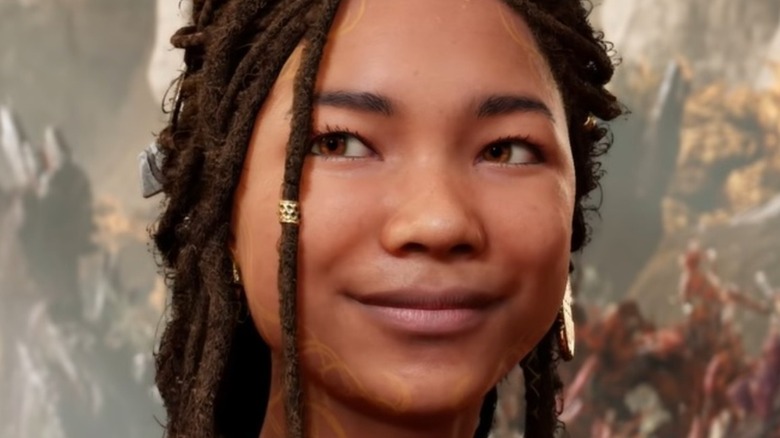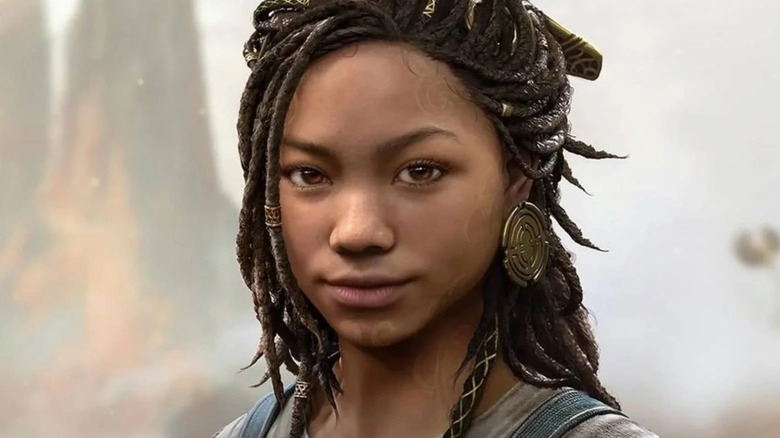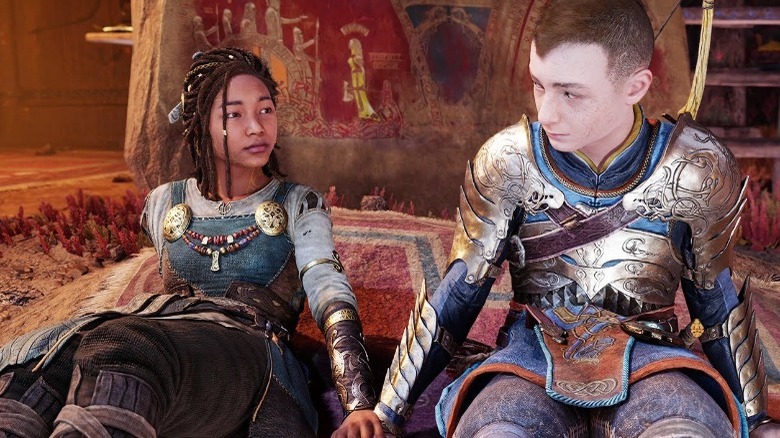Why God Of War's Angrboda Means More Than You Realized
The "God of War" franchise doesn't exactly follow the legends that it borrows from to the letter, but it does take heavy inspiration from them. While the original games were largely based upon the mythos of Ancient Greece, Santa Monica Studios' 2018 "God of War" and its equally critically successful sequel, "God of War Ragnarok" are largely based on old Norse myths and legends. The gods, like Thor and Odin, might be easy enough to recognize, but these games also feature several lesser known characters from Norse mythology, such as Fenrir, Jörmungandr, and Hel. These characters are very different in the games from how they are portrayed in the "Prose Edda" and the "Poetic Edda" — two of the only surviving written texts that depict the history of Norse Myth which was primarily passed down orally.
Another character who was vital to the events leading up to the Ragnarok myth is Angrboða. This character is featured prominently in "God of War Ragnarok," but many fans may not know the ancient figure from which Santa Monica Studios drew her name. The mythological Angrboða was a Giant from Jötunheim, like the one in the game, but she was also Loki's first wife and was called the mother of monsters.
Angrboda in myth
Anyone who's played through the 2018 "God of War" will likely remember the revelation that Kratos' son Atreus has another name among the giants: Loki. This is a clear indication that Atreus is actually intended to be the Norse trickster god who is responsible for setting the events of Ragnarok in motion. Unfortunately, there aren't nearly as many references to Angrboða in the "Prose Edda" as there are to her husband, but she does play a pivotal role in the story.
In the myth, Fernrir, Jörmungandr, and Hel are actually Loki and Angrboða's children. Fenrir is the giant wolf who devours the sun and then swallows Odin, Jörmungandr is the World Serpent who will poison the ocean and the sky before killing Thor, and Hel is the Goddess of Death who rules the frozen kingdom in Niflheim where the dead who are unworthy of joining their ancestors in Valhalla are forced to reside.
Obviously, these characters aren't Atreus and Angrboda's children in the game, but there are a few threads that tie them together. Fair warning though, there are some spoilers that are unavoidable when talking about Angrboda's role in the story.
Angrboda in Ragnarok
The original Angrboða is not specifically mentioned in the actual events of Ragnarok in either the "Prose Edda" or the "Poetic Edda." It's Loki and their children that are referenced as playing pivotal roles in the world-ending battle. She doesn't seem to have much of a part in it, other than being their mother. This doesn't seem to be the case in the games, however.
In "God of War Ragnarok," players learn that Angrboða is a Jötunn, a Giant from the realms of Jötunheim and Muspelheim, just like the myth she was based on. Players don't learn a lot about her character, but there are a few moments that seem to suggest romantic tension between her and Atreus. She then gives him a bag of marbles and explains that each of the orbs inside contain the souls of the Giants of Jötunheim. She teaches him how to use this soul transfer magic in order to resurrect the spirits of the Giants. Atreus later uses this technique to implant the soul of his dead wolf Fenrir into the body of the giant wolf Garm. So while neither of them is actually Fenrir's parent – in a way – Atreus created him with Angrboða's assistance.
It will be interesting to see how Santa Monica Studio's version of Ragnarok plays out, and what kind of role Angrboða will have in it.



